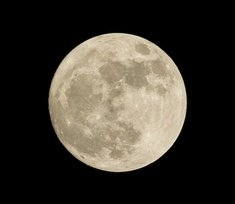|
Hint
|
Answer
|
|
The fifth largest satellite in the solar system and the second densest. Apollo 8 famously landed on this moon. Neil Armstrong was the first to set foot on it.
|
Earth's Moon/The Moon/Luna
|
|
Named after the greek god of fear.Discovered by Asaph Hall III in 1877. Geological features on this moon of Mars, including the Stickney Crater, are primarily named for either astronomers (Stickney was the maiden name of Asaph Hall’s wife) or characters from Jonathan Swift’s Gulliver’s Travels. In 1971 the US’ Mariner IX became the first spacecraft to provide close-up photos of it.
|
Phobos
|
|
One seventh the mass of the above and further away from the Martian surface, it was found by Asaph Hall at the US Naval Observatory six days before he discovered the above. Its largest and only named craters are Swift and Voltaire.
|
Deimos
|
|
The innermost of the four Galilean moons of Jupiter (the moons discovered by Galileo), the fourth-largest moon in the solar system, the densest moon, and the most geologically active body in the solar system due to its more than 400 volcanoes. Named after a Greek story.
|
Io
|
|
The largest moon in the solar system and the only one known to have its own magnetosphere. The third of the Galilean satellites, this moon was also first photographed close-up by Pioneer 10 in 1973. Named after the aristocratic Trojan Zeus kidnapped to be his cupbearer.
|
Ganymede
|
|
The largest moon of Saturn and the second largest in the solar system. It is the only known satellite with a dense atmosphere—so dense that it makes observation of surface features nearly impossible except from close up—and also the only known satellite for which there is evidence of stable bodies of surface liquid. Discovered in 1655 by Christiaan Huygens, it was visited by the Cassini-Huygens mission in 2004.
|
Titan
|
|
Saturn’s third-largest moon after Titan and Rhea and, like them, was discovered by Giovanni Cassini in 1671. It was named based upon a suggestion from John Herschel (son of the discoverer of Uranus, William Herschel) for the Titans of Greek mythology, the brothers and sisters of Cronos (Saturn). In 2004 the Cassini orbiter found an equatorial ridge running over 800 miles long and 10 miles wide that gives Iapetus some of the highest peaks in the solar system; its existence has not yet been explained.
|
Iapetus
|
|
One of Uranus’s largest moons; Named after a character from Shakespeare’s A Midsummer Night’s Dream. (Other Uranian moons are named for characters from either Shakespeare or Alexander Pope.) It was discovered in 1787 by William Herschel, who also discovered Uranus itself in 1781.
|
Titania
|
|
One of Uranus's largest moons; It was discovered the same day as the above. Named after a character from Shakespeare’s A Midsummer Night’s Dream.
|
Oberon
|
|
The largest moon of Neptune and the only large moon with a retrograde orbit (that is, an orbit opposite to the rotation of its planet). The seventh-largest moon in the solar system and is thought to have been captured from the Kuiper Belt. Its name comes from Poseidon and Amphitrite's child.
|
Triton
|
|
The largest satellite of the dwarf planet Pluto, it wasn’t discovered until 1978. (As of 2013, Pluto has five known moons, the last two discovered in 2011 and 2012.) Unlike Pluto, which is covered with nitrogen and methane ice, it appears to be covered in water ice and may also have active cryo-geysers. Its name comes from the Greek ferryman that brings the dead across Styx and to Hades.
|
Charon
|

